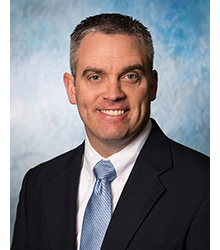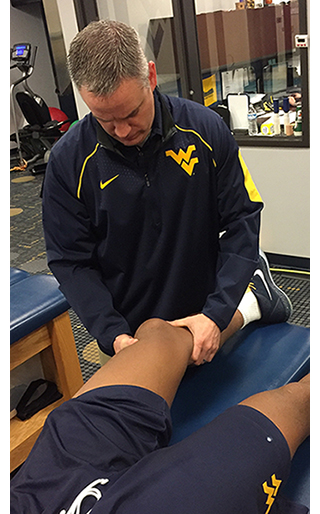A Day in the Life of a PA in Orthopaedics
Consider Galaxy Conference to Learn About Orthopaedics
January 14, 2020
By Travis Randolph, PA-C, ATC

Have you ever injured muscle, bones, ligaments, or joints? Whether it is your own injury or a family member’s injury, most people will be exposed to the field of orthopaedics. It may be a supracondylar humerus fracture sustained on the playground as a kid, a torn Anterior Cruciate Ligament (ACL) playing basketball in high school, or osteoarthritis of a joint developed later in life.
These injuries may range from a very minor sprain to a trauma with catastrophic injury. Regardless of the severity, orthopaedic injuries can be debilitating and devastating to patients. As a PA working in orthopaedics, it is very rewarding and fulfilling to play a role in diagnosing and treating injuries that allow for patients to fully return to their daily activities. It could be reconstructing an ACL for an athlete to return to competition, fixing a fracture that allows someone to walk again, or replacing an arthritic hip joint so a patient can continue fishing. I find being a PA in orthopaedics tremendously satisfying — I can improve my patients’ quality of life.
I began my career as an athletic trainer, but have now been working as a PA in orthopaedics for almost 10 years. I was able to interact with several PAs during my time as an athletic trainer, and they were very influential in my decision to attend PA school. I graduated from the University of Florida in 2008 and have been working in the Department of Orthopaedics at West Virginia University (WVU) Medicine since.
REGISTER FOR THE 2020 MUSCULOSKELETAL GALAXY
For the past 10 years, my primary focus has been on sports medicine. I function as a surgical assistant in the operating room two or three days a week; I typically scrub in on cases that require ligamentous graft preparation. In addition to my clinical work, I am the Clinical Director of Sports Medicine in association with WVU Athletics. This expanded role allows me to combine my skills as a PA and an athletic trainer to improve access to medical care for all our student athletes. When I am not assisting with surgery or seeing patients in the clinic, I visit with teams on campus and evaluate student athletes in the athletic training rooms on an as-needed basis. I assist the team physicians in delivering medical care to the WVU athletes for both orthopaedic and general medical conditions and facilitate orders and scheduling for diagnostic imaging, special procedures, or tests and specialty referrals. My days are busy but rewarding.
Here’s an idea of what a PA in orthopaedics experiences during a normal week day.
6:00 am
I have a 10-20-minute commute depending on traffic. I never mind an early morning start in the operating room—getting to work is a little easier! This morning I’m assisting with a knee surgery for an ACL/ LCL reconstruction. I greet the patient at 6:30 and make sure he is consented and updated for the procedure. I answer his questions and make sure he’s scheduled his physical therapy. Then, I review the x-rays and MRI and discuss the surgical plan with the surgeon. My primary role during surgery is the graft preparation. We typically use autograft tissue, either hamstring or patella tendon, for ligamentous reconstruction. For this multi-ligamentous reconstruction case, we chose to use allograft tissue to reconstruct the ligaments and avoid any further injury to the patient’s knee. The allograft tissue has to thaw, and once it is thawed, I suture the ends of each graft and place them under tension until the surgeon is ready for placement. I assist with drilling the bone tunnels and placing the grafts. Once the grafts are securely fixed, I close all the surgical incisions and apply the post-op dressing and knee brace. After completing the post-op orders and notes, I check my phone for messages. I have received five texts this morning: four requests from athletic trainers to evaluate student athletes and a question regarding imaging. This is my only ligamentous reconstruction case today, so I start returning messages and scheduling appointments for evaluations.
10:00 am
I leave the hospital and stop by the baseball athletic training room to see a student athlete who has been sick for the past couple of days. I examine him, then discuss treatment for his sinusitis. I make sure he has everything he might need prior to leaving for a series of games on the road. After the student athlete leaves, the athletic trainer and I discuss MRI results from another of his players who sustained an elbow injury last week. We discuss the treatment plan and rehab guidelines.
10:30 am
I head back to my office to check emails and patient messages. I receive several patient messages each day: post-op questions, physical therapy scripts, medication refills, work notes, and new patient referrals. It is my responsibility to follow up on these requests and return phone calls to patients. I send in a refill for an anti-inflammatory for a patient and make sure they have a follow-up visit scheduled in clinic. I return a phone call to a patient who has questions regarding wound care instructions following his knee surgery. I try to take a few minutes to check these messages multiple times throughout the day to ensure a timely response for patients. I return a few emails before it’s time to leave for another evaluation.
11:00 am

I make my way over to an on-campus athletic training room to evaluate two student athletes. The first is a wrestler who underwent shoulder surgery two weeks ago. I check his surgical sites and range of motion. He still wears his shoulder brace but appears to be doing well with the rehab protocol. I remove his sutures and schedule his next follow-up appointment. I then examine a student athlete, a rower, who is experiencing lower back pain. She has tight hamstrings from training that appear to be contributing to her condition. I discuss modifying her workouts with the athletic trainer as she gets started in rehab. I then meet with the women’s soccer athletic trainer to schedule an MRI for one of her student athletes who sustained a knee injury yesterday.
12:00 pm
It’s lunch time, and today I meet up with a group of colleagues for a concussion care management conference. Healthcare providers in sports medicine, emergency medicine, neurology, and physical therapy meet once a month to discuss certain concussion cases and protocols as well as review recent literature regarding head injuries. It is very insightful to get different perspectives from each specialty. Just as our meeting is wrapping up, I get a text to evaluate a wrestler for a laceration that may need sutures.
1:15 pm
I head back to the athletic training room to evaluate the wrestler. He sustained a laceration just above his right eyebrow during practice today. I discuss options with the athlete, and he wishes to have it repaired. I thoroughly cleanse and anesthetize the area and suture it closed. I provide him with wound-care instructions and plan to see him next week.
1:45 pm
I stop by volleyball practice to check on one of the players who is recovering from a foot injury and just started practicing with the team again. I watch practice to see how she performs while running and jumping. I meet with the athletic trainer and coaching staff to see how they feel about her progression. She seems to be tolerating practice very well; everyone is happy.
2:00 pm
I drive over to the WVU Medicine outpatient clinic to see the eight patients I have scheduled this afternoon. I review labs that came in yesterday and notify patients of the results. I return a call to a patient regarding his recent shoulder MRI. His MRI confirms a rotator-cuff tear, and I discuss his treatment options. He hasn’t made any improvement in physical therapy and wishes to proceed with surgery. I will turn in an OR card, so he can be scheduled for surgery. I return another call to a patient who wishes to return to work after knee surgery. His line of work will allow for modifications, so I fax him a note to return to work on light duty. Two of the patients are two weeks post-op—one who underwent ACL reconstruction and one received rotator-cuff repair. Both patients are recovering well from their operation. Another of my appointments is a return patient that I’ve been managing who has osteoarthritis of his knee. His knee pain has started to flare up again after recent activity. He is not interested in proceeding with knee-replacement surgery at this time, so I inject his knee with a corticosteroid. He is pleased with the results of the injection, and I provide him with a script for physical therapy. A new patient presents with ankle pain after an injury three days ago. She describes an inversion mechanism after stepping in a hole. Her exam reveals lateral ankle pain with mild soft tissue swelling. I order x-rays of her ankle to complete the exam. The x-rays are negative for fracture, so I order her an ankle brace. I discuss the x-ray findings with the patient and provide her with a script for physical therapy. She is glad to hear that it isn’t anything more serious. I finish up with patients and complete my charting for the day.
5:00 pm
I head back to the hospital for my last meeting of the day. I’m interviewing an advanced practice provider (APP) to join our Senior Council. In 2013, I was designated as the lead PA for WVU Medicine. We developed an APP Council to address the needs of PAs and NPs within our institution. We have seen tremendous growth in APP positions at our hospital, and this structure allows APPs to stay informed on the latest developments. The candidate I’m interviewing is interested in our Pediatric senior position. The interview goes well, and I can now head home to see my family and eat dinner.
Since I have both surgical and clinical responsibilities, in addition to administrative tasks, my current role may not be the most typical of PAs working in orthopaedics. I work with several other PAs in Orthopaedics who take routine call, perform consults in the Emergency Department, round on inpatients, first assist in the operating room, and see patients in an outpatient clinic. Each PA’s role varies slightly, and is often determined by their practice environment. For me, I love the different aspects of my job. Each day is different, and I’m constantly on the move. Most of my appointments are scheduled on an as-needed basis in an effort to evaluate and treat injuries as efficiently as possible.
For any PA who practices in orthopaedics – or is interested in doing so – I would recommend attending AAPA and AAOS’s Musculoskeletal Galaxy conference. This year is the 12th Annual Musculoskeletal Galaxy conference, taking place June 3 – 7, 2020, in Atlanta, GA. This conference offers hands-on pre-course workshops for casting and splinting, and injection techniques. The conference will include presentations from orthopaedic surgeons and PAs that cover topics in all orthopaedic subspecialties. In the small breakout sessions, learn physical exam techniques, participate in a hands-on surgical skills lab for fracture fixation, discuss common radiology cases, and refine your skills in orthopaedic fracture management. Register today, and I’ll see you there!
Travis Randolph, PA-C, ATC practices in orthopaedics at WVU Medicine. He can be reached at [email protected].
This article was originally published on April 13, 2018.
Thank you for reading AAPA’s News Central
You have 2 articles left this month. Create a free account to read more stories, or become a member for more access to exclusive benefits! Already have an account? Log in.



